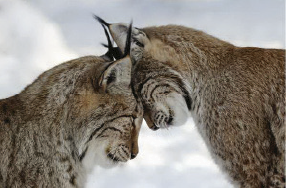
Lynxes have long settled in the Belovezhskaya Pushcha
The Deputy Director General for Science at the Belovezhskaya Pushcha National Park, Vasily Arnolbik, said that photo snares are already being used to study the ecology of the wolf both in Poland and in Belarus. Tracking of movements, or remote monitoring of animals, is being worked on in the Belarusian part of the forest. In Germany, special GPS/GSM-transmitters are now being made. With the help of a network of mobile operators they will send information about the animals in the form of SMS messages. The most difficult thing with a project such as this is to trap the animals and fasten transmitters onto them.
Scientists discussed the development of cross-border researches into wolf and lynx ecology at an international working meeting in the Belovezhskaya Pushcha. The Mammal Research Institute at the Polish Academy of Science performed definitive research into wolves at the end of the last century, but there is a need to study the animal further. In particular, it will be interesting to discover how the number of large predators has changed with the increase in the protected zone of the Belovezhskaya Pushcha.
Oleg Shchitov, the forest’s hunting expert, is convinced that our part of the forest is one of the most interesting territories for studying wolves. The numbers of this animal are actively regulated throughout the whole of the region, while in the protected zone of the National Park, which takes in almost 60,000 hectares, there is no hunting. In the Belovezhskaya Pushcha they impose a moratorium on the cull of wolves just like other areas.
Representatives at the meeting in the Belovezhskaya Pushcha also discussed the development of a common programme to study the lynx. Polish colleagues consider it a less resilient predator than the wolf, and are concerned that the development of forestry in unprotected areas is a threat. Specially protected nature areas are of key importance for the conservation of this rare beast. Work on the tracking of wolves and lynxes in the Belarusian part of the forest is part of the conservation programme, in this they co-operate with the National Park and APB-BirdLife Belarus non-governmental organisation. Rare photos taken with the help of camera snares can be seen on the ‘Channel of the Wild Nature from the Belovezhskaya Pushcha’, available on the website of the APB-BirdLife Belarus organisation and on social networks.
By Alena Yasko











